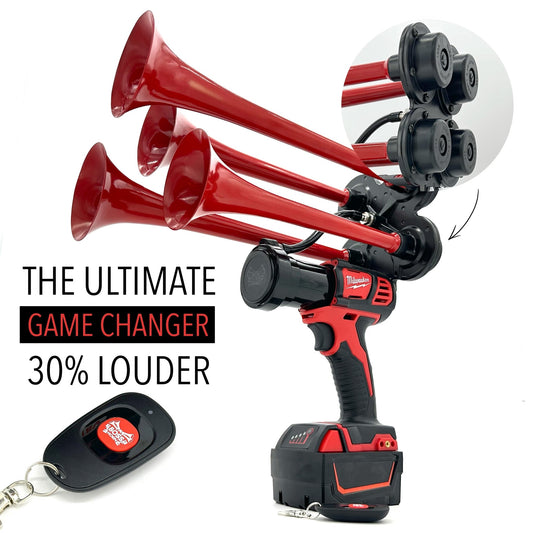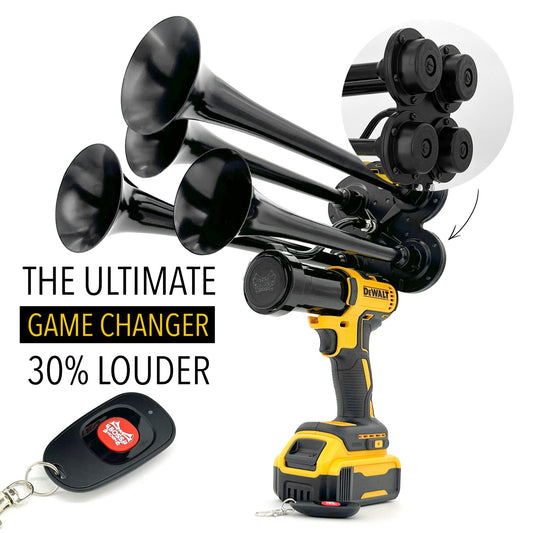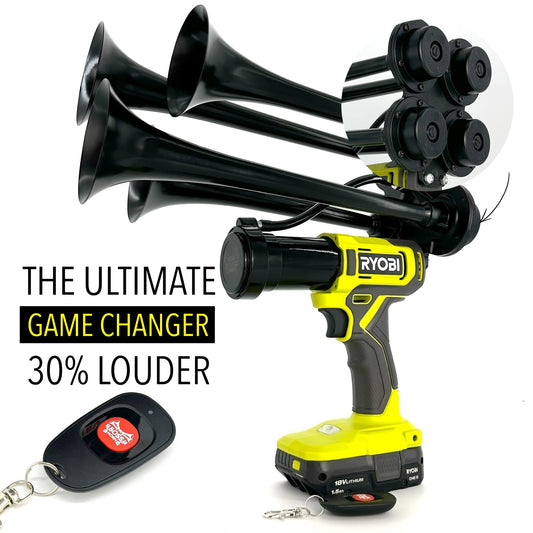A key safety feature for vessels out at sea, the marine digital horn plays a crucial role in alerting nearby ships of their presence, regardless of poor weather conditions or challenging navigational environments. With the advancements in technology, the marine digital horn has emerged as a reliable and efficient alternative to traditional air horns.
Over time, the marine digital horn has undergone significant improvements to meet the evolving needs of the maritime industry. In the past, vessels relied on manual signaling using air horns, which were limited in range and often affected by atmospheric conditions. However, with the introduction of marine digital horns, these shortcomings have been addressed, bringing about a new era of maritime safety.
The significance of marine digital horns lies in their ability to emit loud and distinctive signals that can be easily recognized by surrounding ships, promoting effective communication and ensuring safe passage. Unlike traditional air horns, which require manual manipulation, marine digital horns can be conveniently operated from a central control panel, facilitating swift alarms and responses when necessary.
Notably, the integration of digital technology has not only enhanced the functionality of marine horns but also improved their overall reliability. With electronic modules and automated controls, marine digital horns are capable of self-monitoring, ensuring their continuous operation and dramatically reducing the risk of failure. This advancement has had a profound impact on maritime safety by minimizing the possibility of communication breakdowns or accidents due to faulty signaling devices.
It's interesting to note that the growing demand for marine digital horns has led to their widespread adoption across the maritime industry. As per statistics, there has been a significant rise in the installation of these advanced signaling systems on all kinds of vessels, ranging from small pleasure crafts to massive cargo ships. This trend further emphasizes the indispensability of marine digital horns in ensuring the safety and smooth operation of maritime traffic worldwide.
In conclusion, the marine digital horn has emerged as an essential component for maritime safety, succeeding traditional air horns with its enhanced functionality and reliability. By enabling clear and effective communication in adverse conditions, these advanced signaling systems contribute significantly to the safe navigation of vessels. As the maritime industry continues to embrace technological advancements, the demand and significance of marine digital horns are expected to further increase in the foreseeable future.
What are the benefits and features of a marine digital horn?
A marine digital horn is an advanced electronic device used in marine vessels, specifically boats and ships, to produce an audible sound signal for various purposes. This innovative horn utilizes digital technology to generate clear and precise horn sounds, ensuring optimal safety and communication capabilities in the marine environment. Unlike traditional horn systems, a marine digital horn offers a range of advantages including enhanced sound quality, adjustable volume levels, programmable signals, and compatibility with modern communication networks. In the following sections, we will delve into each of these features in detail, providing a comprehensive overview of the benefits and versatility of a marine digital horn. Stay tuned to discover how this cutting-edge technology revolutionizes sound signaling in maritime environments.
What is a Marine Digital Horn?
A marine digital horn is a device used on boats and ships to produce loud and clear sound signals. It is an essential safety feature that is used to communicate messages and alerts to other vessels, crew members, and nearby individuals. The digital technology incorporated into this horn allows for improved performance and reliability compared to traditional manual horns.
Advantages of Marine Digital Horns
- Enhanced Sound Quality: Marine digital horns are designed to produce clear and sharp sound signals, ensuring that the messages are heard even in noisy maritime environments. The digital technology eliminates any distortions or loss in sound quality.
- Longer Lifespan: These horns are built to be durable and withstand harsh marine conditions. They are resistant to corrosion, water, and UV radiation, which prolongs their lifespan and ensures optimal performance over time.
- Easy Installation: Marine digital horns are easy to install and require minimal maintenance. They come with comprehensive installation instructions, making it convenient for boat owners or technicians to set up the horn correctly.
- Wide Range of Tones: With digital technology, marine horns can offer a variety of tone options to suit different situations and messages. This flexibility allows for effective communication on the water.
- Energy Efficiency: Digital horns are designed to consume less power compared to traditional horns, making them environmentally friendly and cost-effective.
Applications of Marine Digital Horns
Marine digital horns find numerous applications in the maritime industry:
- Emergency Situations: In case of emergencies such as collision alerts, fire, or man overboard situations, the digital horn is used to quickly signal for help and communicate distress messages to nearby vessels.
- Navigation: The horn is utilized to signal the boat's presence and intentions to other vessels, especially during foggy conditions or in busy waterways where there is a risk of collision.
- Docking and Departing: When arriving or departing from a dock or marina, the digital horn is used to indicate the boat's movement and alert others in the vicinity.
- Warning Signals: Digital horns can produce loud and attention-grabbing tones to warn nearby vessels of potential dangers or hazards, ensuring safety during navigation.
Statistics on Marine Safety
According to the latest statistics from maritime organizations and authorities:
- In the year 2020, there were a total of 1,486 reported maritime accidents worldwide.
- These accidents resulted in 1,847 fatalities and 1,349 injuries.
- The leading causes of these accidents were collision, grounding, and capsizing.
- Improved communication and safety equipment, such as marine digital horns, can greatly reduce the risk of accidents and enhance maritime safety.
https://youtube.com/watch?v=t4nfLKwKuHw
FAQ: Marine Digital Horn
1. What is the purpose of a marine audio signaling device?
A marine audio signaling device serves as a crucial safety measure for marine vessels by providing effective communication signals. With its distinct sound patterns, this device is used to convey important messages, warnings, and alerts to other vessels, as well as to notify individuals on board about various situations.
Key information:
- Marine audio signaling devices are essential for marine vessel safety.
- These devices provide communication signals through distinct sound patterns.
- They are used for conveying messages, warnings, alerts, and notifications.
2. How does a marine audio signaling device work?
A marine audio signaling device works by utilizing advanced digital technology to produce audible signals. It is designed to generate a range of sound patterns, such as horns, sirens, or bells, which can be easily recognized and understood by those in marine environments. These devices are equipped with built-in amplifiers and speakers that ensure optimal strength and clarity of the audible signals. Additionally, they are designed to withstand harsh marine conditions, including moisture, corrosion, and vibrations, making them highly reliable in various maritime situations.
Key information:
- Marine audio signaling devices use digital technology to produce audible signals.
- They generate sound patterns like horns, sirens, or bells.
- Built-in amplifiers and speakers ensure optimal strength and clarity of the signals.
- These devices are designed to withstand harsh marine conditions.
3. Are marine audio signaling devices compliant with marine safety regulations?
Yes, marine audio signaling devices are designed to meet and exceed the safety regulations set by recognized maritime organizations. These devices undergo rigorous testing to ensure they meet the required standards for audibility, reliability, and overall performance. They are certified by authorized agencies and marked with appropriate labels or symbols that indicate their compliance with safety regulations. By using compliant marine audio signaling devices, vessel operators can fulfill their safety obligations and reduce the risks associated with maritime operations.
Key information:
- Marine audio signaling devices comply with marine safety regulations.
- They undergo rigorous testing to meet required standards.
- Certified by authorized agencies, they are marked with appropriate labels or symbols.
4. Can marine audio signaling devices be integrated with existing vessel communication systems?
Yes, marine audio signaling devices can be seamlessly integrated into existing vessel communication systems. These devices are designed to be compatible with various communication protocols and interfaces commonly used on marine vessels. By connecting the marine audio signaling device to the vessel's communication network, it can receive signals or instructions from the ship's control system and respond accordingly. This integration allows for synchronized and coordinated communication, enhancing overall safety and situational awareness on board the vessel.
Key information:
- Marine audio signaling devices can be integrated with existing vessel communication systems.
- They are designed to be compatible with various communication protocols and interfaces.
- Integration enables synchronized and coordinated communication.
5. What are the benefits of using a marine audio signaling device?
Using a marine audio signaling device offers several key benefits to vessel operators. Firstly, it enhances communication capabilities by providing clear and audible signals that can be easily understood by both crew members and nearby vessels. This improves safety awareness and reduces the potential for accidents and collisions. Secondly, these devices are highly reliable in challenging marine environments, ensuring consistent performance even in adverse conditions. Lastly, their compliance with safety regulations helps vessel operators meet their legal obligations and avoid penalties or consequences related to non-compliance.
Key information:
- Marine audio signaling devices enhance communication capabilities.
- They improve safety awareness and reduce the potential for accidents.
- These devices are highly reliable in challenging marine environments.
- Compliance helps vessel operators meet legal obligations and avoid penalties.
Conclusion
The marine digital horn is a revolutionary device that has changed the way boats and ships signal their presence in water. It offers numerous advantages over traditional horns, including enhanced audio quality, customizable sound patterns, and user-friendly digital controls. The incorporation of advanced technology ensures reliability and durability, even in harsh marine environments. The marine digital horn offers improved safety by providing clear and audible signals to other vessels, reducing the risk of collisions. Its compact and lightweight design makes it easy to install and maintain. Additionally, the horn's digital capabilities enable integration with other marine safety systems, further enhancing overall safety measures. The marine digital horn has unquestionably become an essential piece of equipment for any boat or ship, ensuring effective communication on the water and contributing to a safer marine environment.














